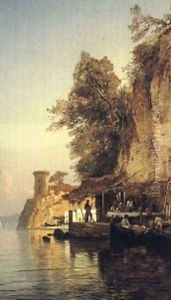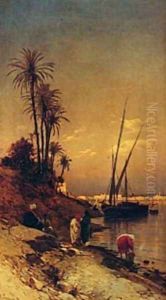Corrodi Hermann David Paintings
Hermann David Salomon Corrodi was an Italian painter of the 19th century, known for his Orientalist and landscape works. Born on July 19, 1844, in Frascati, near Rome, Italy, Corrodi came from an artistic family; his father, Salomon Corrodi, was also a painter, and his brother, Arnold Corrodi, was an artist as well. He was initially taught by his father and then continued his education at the Accademia di San Luca in Rome.
Corrodi's work was heavily influenced by his travels to the Near East, Egypt, and North Africa, which were popular destinations for European artists during the 19th century. These experiences helped Corrodi develop a keen interest in Orientalist painting, a genre that depicted the people, cultures, and landscapes of the East. His paintings often featured historical and biblical scenes set in these exotic locales, rendered with meticulous detail and a masterful use of light.
In addition to his Orientalist subjects, Corrodi also painted Italian landscapes and historical scenes. His works exhibit a romantic fascination with nature and the ancient world, and they were well-received by the public and critics alike. During his lifetime, Corrodi achieved considerable success and was commissioned by various royal patrons, including Queen Victoria of the United Kingdom, for whom he painted several works.
Corrodi's paintings were exhibited widely in Europe and gained him memberships in various art institutions. His reputation extended beyond Italy, and he became one of the most prominent Orientalist painters of his time. Despite the popularity of his work during his lifetime, Corrodi's fame diminished after his death, as the taste for Orientalist art waned in the 20th century.
Hermann David Salomon Corrodi died on January 30, 1905, in Rome. Today, his paintings can be found in private collections and museums around the world, and they continue to be studied by those interested in 19th-century European art, particularly the Orientalist movement. His works stand as a testament to the allure of the East in Western art and the romanticized visions that characterized the period.

